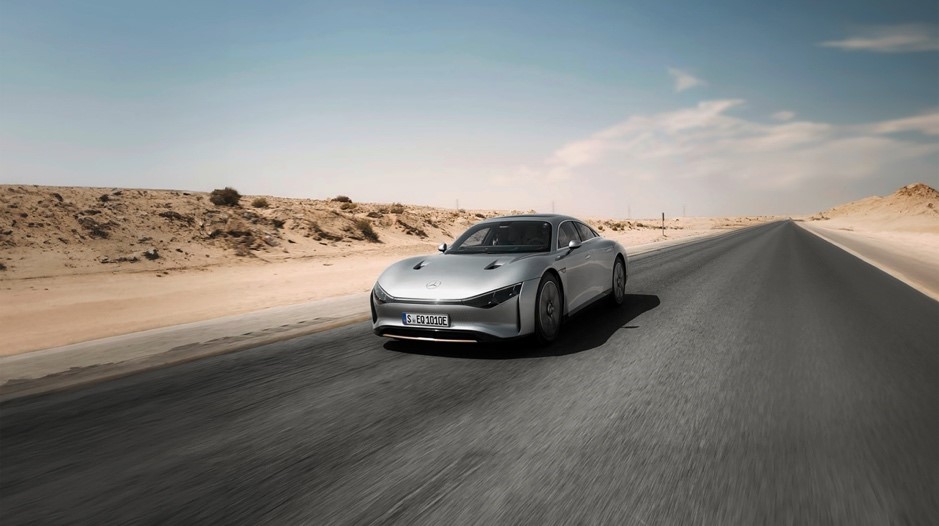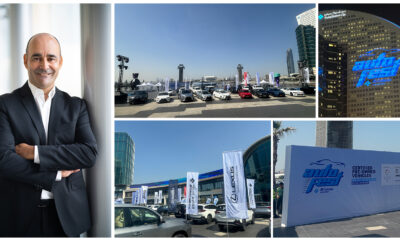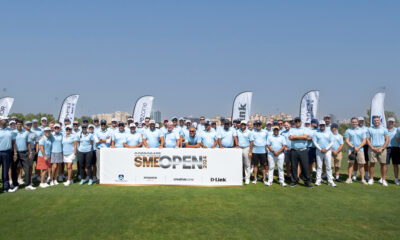Automotive
Maximum transparency: Mercedes-Benz is the world’s first car manufacturer to X-ray a crash test.

The technical sensation begins with a very loud bang. At 60 km/h, a device with a crash barrier rams into the orange C-Class saloon and hits it full on the side. Crash tests are always something special – even for the experts. But the spectacular part of this side impact test is located in a frame on the hall ceiling above the vehicle: A linear accelerator serves as an X-ray camera. Together with the Fraunhofer-Institute for High-Speed Dynamics, the EMI (Ernst Mach Institute) in Freiburg, Mercedes-Benz has now carried out the world’s first X-ray crash with a real car. On board was one SID II dummy on the left-hand side facing the impact. This is a test specimen with a female anatomy, specially designed for side impact tests.
This technology demonstration (proof of concept) at the EMI research crash facility in Freiburg has shown that high-speed X-ray technology can be used to visualise highly dynamic internal deformation processes. Previously invisible deformations and their exact processes thus become transparent. The numerous, high-resolution images allow precise analysis.
“The Mercedes-Benz X-ray crash sets a milestone in the development tools of the future. With a direct view into the hidden interior, it can help to draw important conclusions for the further improvement of vehicle safety. Mercedes-Benz thus confirms its role as a safety pioneer in automotive engineering.”Markus Schäfer, Member of the Board of Management of Mercedes-Benz Group AG, Chief Technology Officer
“The successful X-ray crash provides us with valuable insights to further optimize our technology for capturing previously inaccessible information. Fraunhofer EMI is thus consistently pursuing its strategy of using high-speed X-ray imaging to make dynamic processes visible.” Dr. Malte Kurfiß, Head of Crash Test Centre, Fraunhofer EMI
“The world’s first X-ray crash shows that X-ray technology can provide revealing new insights. We learn what happens inside a vehicle and to the dummies during an accident. The X-ray images also offer the opportunity to further improve the model quality of the digital prototypes.” Prof. Dr Paul Dick, Director of Vehicle Safety, Mercedes-Benz AG
Ultrashort X-ray technology: up to 1,000 images per second
For several years, the Mercedes-Benz vehicle safety division has been researching the use of X-ray technology in crash tests together with colleagues from EMI. The decisive factor for the breakthrough was the use of a linear accelerator with 1 kHz technology as the radiation source. The device is far more powerful than the X-ray flashes previously used in trials: The photon energy of the linear accelerator is up to nine megaelectron volts. This allows all materials commonly used in vehicle construction to be screened. The duration of the X-ray pulse is only a few microseconds. This makes it possible to record deformation processes in the crash test without motion blur. The linear accelerator also generates a continuous stream of these X-ray pulses. This means that up to 1,000 images per second are possible. That is about 1,000 times as many as with conventional X-ray procedures.
During the crash test, the beams shine through the bodywork and any dummies from above. A flat detector is located under the test vehicle. It serves as a digital image receiver in the X-ray system: When the radiation hits the detector, an electrical signal is generated. The intensity of this depends on how strongly the radiation was previously absorbed by the vehicle and dummy structure. This influences the grey value that is later visible – similar to the X-ray inspection of luggage at the airport or images of this kind taken by a doctor.
In the milliseconds of the actual impact time, the X-ray system shoots around 100 still images. Combined into a video, they provide highly exciting insights into what happens inside safety-relevant components and in the dummy’s body during a crash. In this way, it is possible to observe in detail how the thorax of the dummy is pressed in or how a component is deformed. The important part on the way from research to industrial application is the fact that the X-ray crash does not affect any other analysis tools. Even the interior cameras in the crash test vehicle record without any disturbance.
The EMI experts drew up a comprehensive radiation protection concept for the X-ray crash. Dosimeters are used as monitors to ensure that employees are not exposed to radiation. The government authority has approved the operation of the plant in accordance with legal requirements. The elaborate physical protection measures include an additional 40-centimetre-thick concrete wall around the building and a protection door weighing around 45 tonnes.
Crash tests: Part of Mercedes-Benz’s “Real Life Safety” philosophy
On 10 September 1959, the first crash test in the history of Mercedes-Benz took place – on open ground close to the plant in Sindelfingen. A test car was driven head-on into a solid obstacle. This opened a new chapter in safety research at Mercedes-Benz, as it made it possible to study the crash behaviour of both vehicles and occupants under realistic conditions using test cars and dummies. Together with the analyses of the Group’s own accident research, crash tests form the basis for the “Real Life Safety” philosophy.
Mercedes-Benz currently carries out up to 900 crash tests per year and around 1,700 “sled tests” at the Vehicle Safety Technology Centre in Sindelfingen. In this crash simulation, a test sled is accelerated and braked. A test object (vehicle body shell or assembly) is mounted on the sled and subjected to the forces arising during a real vehicle crash. These sled tests allow non-destructive testing of individual components, especially restraint systems such as seat belts.
And the world’s first public crash test on two fully electric vehicles in autumn 2023 shows that safety at Mercedes-Benz is not a question of the drive system. EQA and EQS SUV models crash into each other in a real accident scenario at a speed of 56 km/h and an overlap of 50 per cent. The test confirms the high level of occupant protection: The passenger cell and high-voltage battery of both vehicles remain intact as intended, the doors can be opened, and the high-voltage systems switch off automatically.
About the Fraunhofer-Institute for High-Speed Dynamics, the Ernst Mach Institute (EMI)
The Fraunhofer EMI specialises in the physics, engineering and computer science of fast processes in experiments and simulations. The aim is to develop solutions for industrial applications with a focus on reliability, safety, resilience, efficiency and sustainability.
The Fraunhofer EMI deals with crash, impact and shock wave phenomena across all materials. Adopting a comprehensive approach, the institute analyses and optimises the entire range of materials and microstructures through to complex structures. Applications range from materials to components, cars, aeroplanes, satellites, buildings, urban systems and infrastructure networks.
The Fraunhofer Society is the leading organisation for applied research in Europe. Under its umbrella, 76 institutes and research facilities work at locations throughout Germany. More than 30,000 employees generate an annual research volume of more than 2.9 billion euros.
Automotive
JETOUR highlights hybrid off-road innovation and expansion at Beijing Auto Show

JETOUR, an industry-leading, innovative SUV brand held a global press conference at the Beijing Auto Show, providing insights on its strategic advancements and enhanced partnerships, further solidifying its vision of ‘Travel+‘. The event highlighted JETOUR’s ongoing commitment to seamlessly blend travel with technology, offering a glimpse into a future where exploration and innovation go hand in hand.

“China’s ascent in the automotive landscape is a testament to our innovation and drive. As the global auto industry undergoes significant transformations, we at JETOUR remain steadfast in ‘Travel+’ strategy. Our aim is to not just participate but to lead the ‘Travel+’ segment worldwide,” said Ke ChuanDeng, Vice President of JETOUR Auto. “With ‘One World, One JETOUR,’ we have laid down in our ‘Travel+’ footprints across the globe, extending our reach through 600 sales and service networks in over 50 countries and regions. Our readiness to enter into markets with right-hand drive vehicles and our upcoming foray into Europe demonstrates our commitment to global integration.”
Additionally, he highlighted the JETOUR’s dedication to ESG principles, “At JETOUR, we believe in the power of sustainable development. Through our ESG initiatives, we strive to create and contribute tangible value to society, ensuring that as we grow, we do so with responsibility and purpose.”
In a strategic partnership with the Discovery Channel, JETOUR reinforced its ‘Travel+‘ philosophy through the ‘Cheetah Conservation Project.’ merging adventure with ecological mindfulness and environmental stewardship. This project sits within a larger framework of JETOUR’s global ESG activities including supporting women’s health initiatives in Latin America, fostering child development in the Middle East and enhancing traffic safety education across Africa.
JETOUR introduced its super hybrid off-road platform, embodying versatility, energy prowess, intelligent cockpit innovations, and cutting-edge electronic architecture. The super hybrid i-DM system, integrated with a 1.5TGDI high-efficiency engine, a specialised DHT gearbox for hybrids and an advanced battery and management system, promises to revolutionise vehicle performance, energy efficiency and safety standards.
“At JETOUR, we centre our product development around the evolving customer demands in an effort to boost customer satisfaction and forging strong relationships through co-creation and attentive listening. We are dedicated to not just following but shaping this strategy by continuously innovating our ‘Travel+’ products and ecosystem. Our goal is to simplify, enhance and make traveling a more delightful experience for everyone,” said Dai Lihong, Executive Vice President of JETOUR Auto. “By adhering to global standards and regulations, and partnering with renowned global suppliers, we ensure our new products are of the highest quality, maintaining JETOUR’s reputation as a brand that customers can trust and rely on, wherever their travels take them.”
During the press conference, JETOUR Automotive highlighted their ‘Travel+’ series of products, with the spotlight on their hybrid electric T-series lineup. The series is specifically crafted for off-road enthusiasts, including the flagship A+ class T1 plug-in hybrid SUV, equipped with a 1.5TGDI engine, which is expected to enter the market in 2024. In addition, the T2 Plug-in Hybrid Electric Vehicle (PHEV), an innovative travel-oriented hybrid SUV designed for off-road adventures, is set to make its international debut in the fourth quarter. It features a substantial battery capacity for on-the-go charging, enhanced safety features and efficient performance across all speed ranges, ensuring quick acceleration, stable cruising and fuel savings for daily commuters.
The T5 will be JETOUR’s first model featuring a girder structure, equipped with a 2.0T engine designed exclusively for hybrid systems, with an expected launch in an upcoming year.
In addition, the T2 model, a leader in China’s light off-road vehicle market segment, is set to conquer the Middle East market in 2024. In response to market demands, JETOUR is set to release an extended seven-seater version of the T2, as well as a specially modified four-wheel-drive version to enhance off-road experience and convenience.
JETOUR is also set to expand its innovative product lineup with the introduction of the T7, a vehicle that redefines the boundaries between land and water travel. “Looking ahead, JETOUR is poised to revolutionise the concept of travel with the upcoming T7 model, with the ability to cruise over water with the same ease as it can on land,” Dai explained. “This extraordinary vehicle will not only take on challenging terrains but will also have the ability to sail for up to 40 minutes, offering an unparalleled travel experience.”
In alignment with global market trends and consumer preferences, JETOUR is also charting its course in the international arena with a strategic approach to technology adoption. Beyond the hybrid models, JETOUR is committed to continuing the development of gasoline-powered vehicles to meet current market demands. The brand is expected to offer a combination of traditional Internal Combustion Engine (ICE) models alongside advanced Plug-in Hybrid Electric Vehicles (PHEV), ensuring a comprehensive and versatile range of options for consumers worldwide. This dual-technology route underscores JETOUR’s dedication to catering to a variety of needs while upholding its commitment to driving innovation and excellence in the automotive sector.
Over the past years, JETOUR has demonstrated exceptional growth and a burgeoning dominance in the SUV segment. The company boasts the seventh position in China’s automotive export volume and ranks second in growth rate, indicating its undeniable global impact. Leading the market share in Angola and asserting a strong presence in Uruguay’s SUV market, JETOUR’s expansive network, which includes over 600 sales and service centres in more than 50 countries and regions, is a clear indicator of its international reach and ambitions of penetrating right-hand drive and EU/EU-like markets.
As the ‘Travel+‘ vision evolves, JETOUR invites the world to embark on a voyage of discovery and innovation, promising unforgettable journeys. JETOUR is committed to leading the charge in the automotive industry’s future, where travel and technology converge to deliver captivating experiences.

Automotive
VISION EQXX once again delivers groundbreaking energy efficiency of 7.4 kWh/100 km[1] on electric journey from Riyadh to Dubai

On its third long-distance road trip over 1,000+ kilometres, the VISION EQXX technology programme demonstrated that even the Arabian Desert is no obstacle to energy efficiency. On a challenging route profile encompassing busy city streets and open desert, the pioneering test vehicle delivered electric power consumption of 7.4 kWh/100km (8.4 mi/kWh)1. This equates to an equivalent of around 0.9 l/100 km or 282 MPGe for a petrol-fuelled vehicle. In ambient temperatures of up to 34 degrees Celsius (93 degrees Fahrenheit), the VISION EQXX beat its own previous best by a considerable margin.
“With an exceptional consumption of just 7.4 kWh/100 km1, the VISION EQXX continues to provide valuable data for ongoing development of advanced electric efficiency technologies. As expected, all systems performed perfectly in the desert conditions, handling challenges such as road surface finish and temperature as well as dust with ease. Further proof that electric drive is ready for global markets.” Markus Schäfer, Member of the Board of Management at Mercedes-Benz Group AG, Chief Technology Officer
“Embarking on an electric drive from Riyadh to Dubai isn’t just about reaching a destination; it’s about igniting a transformative journey for the Middle East. The VISION EQXX’s groundbreaking drive from Riyadh to Dubai not only symbolizes our commitment to shaping the future of mobility but also fills me with immense pride that this record was achieved in the region. In navigating this transformative path, we’re setting new benchmarks, reinforcing our technology leadership in electric mobility.” Michael Stroband, CEO of Mercedes-Benz Cars Middle East.
Third VISION EQXX trip tests efficiency in the Middle East
The starting point for the efficiency drive on the Arabian Peninsula was the Mercedes-Benz Center in Riyadh, Saudi Arabia. The destination was the recently opened Mercedes-Benz Brand Center in Dubai, UAE. The route of 1,010 km (627.6 miles) was completed in a total driving time of 14 hours and 42 minutes. Having left Riyadh at 4:15 a.m. with a full battery, the VISION EQXX still had 309 kilometres (192 miles) of range left when it arrived in Dubai at 7:57 p.m. The route incorporated urban and sub-urban sections in Riyadh and Dubai with heavy traffic as well as lengthy highway sections across the open desert.
Further chance to test technology features such as thermal management and solar roof
The VISION EQXX has twice proven its ability to cover well over 1,000 kilometres on a single charge (Sindelfingen – Cassis and Untertürkheim – Silverstone). The purpose of this third road trip was to maximise efficiency in all areas and examine system performance under extreme desert conditions. Of particular interest in the dry desert heat of up to 34 degrees Celsius was the car’s advanced thermal management. The intelligent on-demand system kept the electric drivetrain and the cabin cool. The air conditioning system was operational during the trip with minimal negative impact on energy efficiency thanks in part to the multi-source heat pump. A further developed version of this heat pump is integrated into the Concept CLA Class unveiled at IAA Mobility 2023. This close-to-production concept previews the model family based on the Mercedes-Benz Modular Architecture (MMA) and benefits from wide-ranging technology transfer from the VISION EQXX.
The relentless desert sun also gave engineers the opportunity to examine closely the performance of the solar roof on the VISION EQXX. The 117 solar cells are used to power many of the ancillaries, reducing the energy drain on the high-voltage system and further improving overall efficiency. On the drive to Dubai, the system harvested 1.8 kWh of solar energy, adding approx. 24 km to overall range. Research continues into the series-production benefits of this technology. Also relevant for comparative analysis with previous test drives were the data gathered on the influence of wind and sun on efficiency. As well as the temperature of the sun, measurements even include the angle and direction of sunlight.
Teamwork between driver and intelligent assistant maximises energy efficiency
One of the most important factors in the efficiency of any vehicle is and remains the person behind the wheel. The driving team on the efficiency trip are highly experienced experts with specific testing tasks. To help maximise energy efficiency, they took full advantage of the car’s intelligent efficiency assistant. It curates a wide range of available information and suggests the most efficient driving style in real time. This includes data such as the direction and intensity of the sun and wind. For instance, during challenging crosswinds along the coast in the UAE, the system helped the drivers adjust their speed accordingly. For maximum solar yield during stops, the team parked the VISION EQXX in alignment with the sun using the solar information display (Tech View).
An important global ambassador for electric mobility that pairs efficiency with luxury
More than two years after it was unveiled, the VISION EQXX remains an eye-catching crowd puller. During that time, it has also covered 23,340 kilometres (14,503 miles) testing its pioneering electric technology under a wide range of demanding real-life conditions. In a region often associated with super sports cars and full-size SUVs, the compact dimensions and sleek proportions of the VISION EQXX drew intense interest. The slippery drag coefficient of just 0.17 pairs with a sophisticated fastback design to represent a highly desirable ambassador for electric mobility. Likewise, with charging infrastructure still sparse in many parts of the world, this was a valuable opportunity to demonstrate long-range electric efficiency under real-life conditions. Another important aspect of the Mercedes-Benz electrification strategy.
In addition to the two previous road trips in Europe, Mercedes-Benz has also taken the VISION EQXX to audiences in the US and China. This has given key global target groups the chance to experience for themselves a realistic, road-going example of luxurious and sustainable electric efficiency.
VISION EQXX: the trip log in figures
| Start | Mercedes-Benz Center, Riyadh, 8 March 2024, 4:15 a.m. (AST) |
| Arrival | Mercedes-Benz Brand Center, Dubai, 8 March 2024, 7:57 p.m. (GST) |
| Travel route | Riyadh, Haradh, Al Batha, Abu Dhabi, Dubai |
| Driving distance | 1,010 km (627.6 miles) |
| Total travel time / in motion | 14:42 h / 12:45 h |
| Ave. speed | 68.7 km/h (42.7 mph) including vehicle static (1:57 h due to border crossing and driver change) 79.4 km/h (49.3 mph) in motion |
| Max. speed | 140 km/h (87 mph) |
| Ave. consumption | 7.4 kWh/100km (8.4 mi/kWh)1, equalling around 0.9 l/100 km or 282 MPGefor a petrol-fuelled vehicle |
VISION EQXX technology programme: the most important technical data at a glance
| Battery energy content | kWh | <100 |
| Rated voltage | Volts | >900 |
| Cd value | 0.17 | |
| Front face | m2 | 2.12 |
| Power | kW | 180 |
| Wheelbase | mm | 2,800 |
| Length/width/height | mm | 4,975/1,870/1,348 |
| Unladen vehicle weight | kg | 1,755 |
Automotive
Mercedes-Benz VISION EQXX, the Record-Breaking Icon, to Showcase at LEAP 2024 in Riyadh, Saudi Arabia

Mercedes-Benz is set to showcase its record-breaking electric mobility masterpiece, the VISION EQXX, at LEAP 2024, a leading global technology event. The event will take place at the Riyadh Exhibition and Convention Center in Malham, Saudi Arabia, from March 4 to 7, 2024, in collaboration with Saudi Arabia’s telecom service provider, Etihad Etisalat (Mobily).
LEAP, now in its third year, plays a pivotal role in fostering technological advancements, driving digital transformation, and shaping the future of innovation. The event also offers insights into Saudi Arabia’s strides towards achieving the goals outlined in Vision 2030.
The VISION EQXX presents a highly progressive interpretation of the fundamental Mercedes-Benz principles of modern luxury and Sensual Purity for the digital and sustainable age. With more than 1,000 km of real-world electric range on a single charge and energy consumption of less than 10 kWh/100 km, the VISION EQXX is a blueprint for the future of efficiency. Beyond the exceptional achievements of its highly advanced drivetrain, world-beating drag coefficient of 0.17 and lightweight bionic design, it’s also a masterclass in a radically new software-driven approach to the UI/UX. A game engine elevates the UI graphics to a whole new level of digital luxury. The user interface shows how real-time graphics opens up entirely new digital possibilities, reacting immediately to the driver’s needs and bringing the real world into the vehicle.
Setting a new benchmark in electric efficiency, the VISION EQXX recently broke its own efficiency record achieving 8.3 kWh/100 km on a 1,202 km drive from Stuttgart (Germany) to Silverstone (UK) on a single battery charge.
Michael Stroband, CEO of Mercedes-Benz Cars Middle East said: “The VISION EQXX is more than a show car, it’s a testament to Mercedes-Benz’s commitment to accelerating the transition to electric mobility through groundbreaking efficiency and range. LEAP is an exceptional event that aligns seamlessly with our core values of innovation and advancement. It provides a unique platform for tech enthusiasts and industry leaders to collaborate, share insights, and shape the future of technology”.
“We extend our gratitude to Mobily for their collaboration, which has made it possible to showcase this masterpiece at this remarkable event. The VISION EQXX embodies our dedication to pushing the boundaries of electric mobility, and we look forward to sharing its revolutionary features with the diverse and forward-thinking audience at LEAP.”

-

 Tech Interviews2 months ago
Tech Interviews2 months agoNavigating the Cybersecurity Landscape in Hybrid Work Environments
-

 Tech Features3 months ago
Tech Features3 months agoHow Telecommunications Providers Can Best Tackle DDoS Attacks
-

 Tech News4 months ago
Tech News4 months agoGoogle Appoints Ziad Jammal as Google Cloud Country Manager in the United Arab Emirates
-

 Tech News5 months ago
Tech News5 months agoSenet enters MENA’s Competitive Gaming Scene with ‘skill-to-earn’ Platform
-

 Automotive2 months ago
Automotive2 months agoAl-Futtaim Automotive Builds On 23-Year Legacy of Trust & Leadership in UAE’s Pre-Owned Car Market to Sell Over 25,000 Used Vehicles in 2023
-

 Tech News2 months ago
Tech News2 months agoBrighton College Abu Dhabi and Brighton College Al Ain Donate 954 IT Devices in Support of ‘Donate Your Own Device’ Campaign
-

 Events3 months ago
Events3 months agoIntegrator Media Successfully Hosts the Corporate SME Open 2024, Revolutionizing Networking in the SME Sector
-

 News7 months ago
News7 months agoSurveySparrow Expands Footprint in MENA Region with Regional Office and State-of-the-art Data Center












